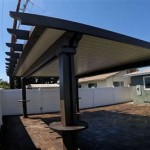Should Your Patio Have a Slope?
When planning a patio, one aspect to consider is the slope of the surface. While a slope is not always necessary, understanding the benefits and drawbacks can help you make an informed decision that suits your needs.
Benefits of a Sloped Patio:
1. Drainage: A sloped patio helps channel water away from the seating and grilling areas, preventing pooling and ensuring a dry surface during rain or snow. Proper drainage also extends the life of the patio by preventing damage from water accumulation.
2. Accessibility: A slight slope can enhance accessibility for individuals with mobility challenges. It creates a gradual transition from the ground level to the patio surface, making it easier to navigate with wheelchairs or walkers.
Drawbacks of a Sloped Patio:
1. Safety: Excessively steep slopes can pose a safety hazard, particularly for children or the elderly. It's essential to maintain a moderate slope for safety and comfort.
2. Drainage Challenges: While a slope facilitates drainage, it can also create challenges if not properly designed. If the slope is too steep, water may run off too quickly, taking away topsoil and potentially damaging nearby landscaping.
Determining the Right Slope:
The ideal slope for a patio depends on several factors, including the size of the patio, the drainage needs, and the surrounding topography. A professional contractor can assess the site and recommend the most suitable slope for your specific situation.
As a general guideline, a slope of 1/4 inch per foot is considered optimal for drainage. However, you may need a steeper slope if there are significant drainage issues or if the patio is located in an area with heavy rainfall.
Alternatives to Sloped Patios:
If a sloped patio is not feasible due to safety concerns or other factors, there are other options to improve drainage:
- Grading: Slope the ground away from the patio to create drainage paths.
- French Drains: Install underground pipes to collect and divert excess water.
- Permeable Pavers: Use permeable pavers that allow water to seep through, reducing surface runoff.
Conclusion:
Whether or not to slope your patio depends on your specific needs and considerations. A sloped patio offers benefits in terms of drainage and accessibility, but it's important to ensure a moderate slope for safety and avoid potential drainage challenges. Consulting a professional contractor can help you determine the best solution for your patio, taking into account factors such as site conditions, drainage requirements, and safety concerns.

How Much Slope Should Your Patio Roof Cover Have
Questions On Sloping A Raised Patio Lawn Care Forum

5 Slope Too Much For Patio Doityourself Com Community Forums

How Do I Slope A Patio Toward One Of Its Corners Home Improvement Stack Exchange

Is My Patio Base Slope Too Steep

Grading A Patio Located Away From House

Block Patio Slope Question Doityourself Com Community Forums

You Can Put A Patio In Sloped Backyard Eagleson Meadows
Building Paver Patio On Slope Pics Lawn Care Forum

What Is A Normal Slope For New Paver Patios Viking Pavers
See Also








